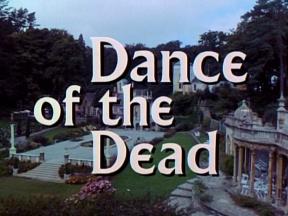 Dance of the Dead
Dance of the DeadTransmission Date: 17/11/1967
Episode Length: 48'26m (DVD timing)/50'19m (Blu-Ray timing)
Est. Ratings: 9.1m
Written by: Anthony Skene
Directed by: Don Chaffey
DVD availability: Try amazon.com
Production Commenced:
September 1966
Production Credits:
An ITC Production by Everyman Films Ltd. Executive Producer: Patrick McGoohan; Script Editor: George Markstein; Producer: David Tomblin; Production Manager: Bernard Williams; Director of Photography: Brendan J. Stafford B.S.C.; Art Director: Jack Shampan; Camera Operator: Jack Lowin; Editor: John S. Smith; Theme: Ron Grainer; Musical Director: Albert Elms; Cameraman (2nd Unit): Robert Monks; Assistant Director: Gino Marotta; Sound Editor: Stanley Smith; Sound Recordist: John Bramall; Music Editor: Eric Mival; Casting Director: Rose Tobias-Shaw; Continuity: Doris Martin; Set Dresser: Kenneth Bridgeman; Make-Up: Eddie Knight; Hairdressing: Pat McDermot and Wardrobe: Masada Wilmot. Made on location and at Metro-Goldwyn-Mayer Studios, Borehamwood, England.
Starring:
Patrick McGoohan (The Prisoner); Mary Morris (Number Two); Duncan MacRae (Doctor); Norma West (Girl Bo-Peep); Angelo Muscat (The Butler); Aubrey Morris (Town Crier); Bee Duffell (Psychiatrist); Camilla Hasse (Day Supervisor); Alan White (Dutton); Michael Nightingale (Night Supervisor); Patsy Smart (Night Maid); Denise Buckley (Maid); George Merritt (Postman); John Frawley (Flowerman); Lucy Griffiths (Lady in Corridor); William Lyon Brown (2nd Doctor); Ray Cannon (Dead Man/Man In Photograph, uncredited); Jill Hennessy (Girl In Photograph, uncredited) and Fenella Fielding (Loudspeaker Voice, uncredited)
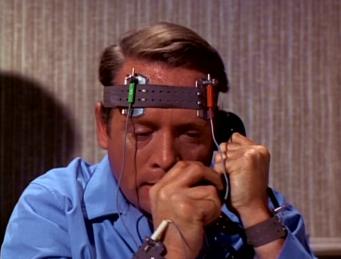
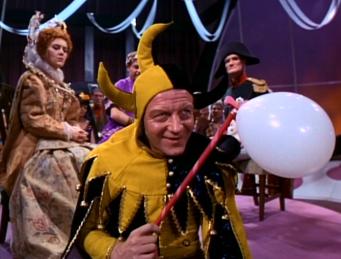
Episode Order:
Produced as one of the first four, Dance of the Dead was set up, as with Checkmate and Free For All, as a possible second episode. Indeed, the episode contains multiple references to No.6 being new to the Village, and I feel few would dispute that it works better as an early episode, rather than episode eight. The reason for it being put back is said to lay entirely with Patrick McGoohan, who, concerned with many facets of the series, wrote it off as incomplete while he satisfied ITC by completing more episodes. Eventually edited together from what footage was shot, one of the biggest casualties was its original ending, which was to give No.6 a more triumphant resolution by having him tell No.2 "being dead does have it's advantages" - then return to the dance, only for it to pull out and fade to black!
If we accept this as the real second episode, then this is the first time we get to see the dialogue exchange between No.6 and No.2, seen every episode (apart from Arrival, then Do Not Forsake Me Oh My Darling, Living In Harmony and Fall Out), overdubbed on images between the episode title and the start of the episode proper: "Where Am I?" "In The Village" "What Do You Want?" "Information" "Whose side are you on?" "That would be telling. We want information... information... information..." "You won't get it" "By hook or by crook we will" "Who are you?" "The new No.2" "Who is No.1?" "You are No.6" "I am not a number. I am a free man!" "(No.2's laughter)" By this virtue, it's also the first time we get to see No.6's horrific brown china dogs... would our hero really have such bad taste?
No.6:
Little new is learnt about No.6 in this episode, except that the outside world believes him to be dead and that he "rarely drinks". An associate (Roland Walter Dutton) is introduced in the episode, who also mentions mutual associates of "Arthur" and "The Colonel". Dutton is described by No.6 as "a man I think I knew" though whether this refers to unfamiliarity with Dutton or Dutton's surprising change in character is not known. Certainly, the two know enough of each other to discuss previous lives, and No.6 acknowledges Dutton didn't have access to high level information. Particularly destructive this episode, a No.6 that makes constant reference to being new in the village presses a cushion up against his tv screen, causing feedback, and smashes a telex machine to pieces. He is also given a costume to wear at the village carnival - his own suit, despite being told it was burnt in Arrival.
In The Village:
The Village Town Hall is protected by a force field. Also, if we accept this episode occurs chronologically before Free For All, then this is the first time we get to see an underground section of the village. Drugged drinks and hypnosis are used to subdue villagers, with No.6 claiming "I've never seen a night". Villager No.34 is revealed as dead, with the implication that he was killed.
Storyline:
No.6 discovers a dead body washed ashore with identification and a radio inside. After sending it back out to sea with a message to let the outside world know of his incarceration, he meets Dutton. Dutton claims that the Village won't believe he knows nothing and is due to be terminated. As No.6 attempts to do something about it, he is put on trial for his life at the Village's annual carnival ball, found guilty of having a radio and breaking Village rules.
Escape:
The body No.6 sent ashore was found by the Village authorities and amended, so that the outside world will find it - but believe it to be No.6 that is dead. After calling Dutton for a character witness to his trial, he finds that he has been turned into a vegetable. The Village decrees No.6 guilty and Villagers chase him to carry out his execution, before he escapes in the underground. There he is met by No.2, where, despite having ripped out its circuits, he finds a telex machine is still transmitting...
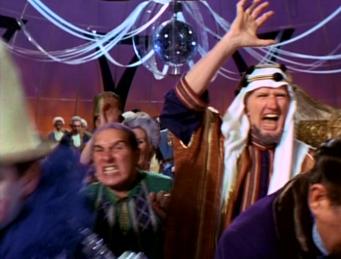
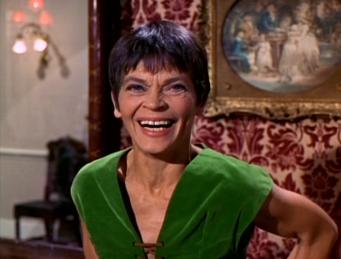
"This place has been going for a long time."
"Since the war? Before the war? Which war?"
Viewpoint:
Dance of the Dead is arguably the darkest and most bleak Prisoner episode of them all. Guest starring the superbly enigmatic Mary Morris as No.2, it represents an aspect of the Village far colder and more lacking in hope than any seen before or since.
Morris offers No.6 no game of cat or mouse� she�s there to extract what she can, and No.6 is on borrowed time to tell them what he knows before they take it. The scene where Ronald Walter Dutton appears lobotomised and stripped of dignity is arguably the coldest and most psychologically disturbing seen in the series.
Many standout moments occur in this underrated episode, an ethereal tale with beautiful cinematography, and my personal second favourite.




